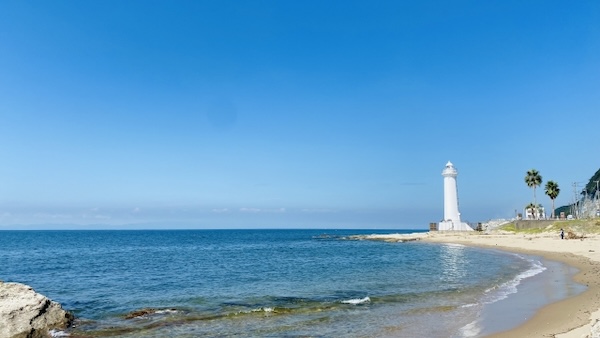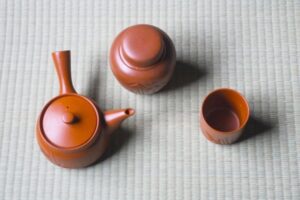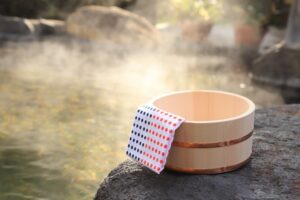The Chita Peninsula offers a wide range of attractions throughout the year, but how you enjoy them varies by season.
In this guide, we’ll walk you through what to expect in spring, summer, autumn, and winter—covering the climate, seasonal highlights, and even tips on what to wear.
Use it to help plan the best time for your trip!
The Climate and Seasons of Chita Peninsula
Let’s start with a quick overview.
In this section, we’ll introduce the general climate of the Chita Peninsula and what kinds of leisure activities are available in each season.
General Climate Overview
Located in southern Aichi Prefecture, the Chita Peninsula enjoys a mild and relatively comfortable climate year-round.
Rainfall is relatively low, and snow is extremely rare—even in winter.
However, since the area is surrounded by the sea, the humidity tends to be high, and it can sometimes feel quite windy.
Temperatures generally range from around 30–35°C (86–95°F) in summer to 5–10°C (41–50°F) in winter, without extreme seasonal shifts.
Summers can feel muggy due to the high humidity, but winters are comparatively mild and manageable.
Seasonal Leisure Highlights
Spring: Relaxing strolls under blooming cherry blossoms and rapeseed flowers
Summer: Seaside fun, fireworks festivals, and refreshing shaved ice
Autumn: Ideal weather for outdoor sightseeing, such as pottery district strolls
Winter: Warm up with hot pot cuisine, onsen (hot springs), and indoor pottery workshops
Each season offers unique charm, giving visitors a different experience depending on when they visit.
Spring (March–May): How to Enjoy Chita in Spring
In spring, the Chita Peninsula is still touched by a slight chill in the air, but the sunlight is warm, and flowers are in full bloom—making it the perfect time for a peaceful walk.
You can enjoy the fresh spring scenery surrounded by cherry blossoms and vibrant yellow rapeseed flowers.
Spring Climate Overview
Warm during the day, slightly chilly in the mornings and evenings.
High pollen count—those with allergies should take precautions.
Cherry blossoms and rapeseed flowers reach full bloom from late March to early April.
What to Wear in Spring
March: A coat or thick outerwear is still necessary.
April: A light jacket is usually enough during the day.
May: A cardigan or long-sleeve shirt should keep you comfortable.
Recommended Spots & Events in Spring
Late March to early April is the best time for cherry blossom viewing.
Among the most accessible and popular hanami (cherry blossom viewing) spots are Ōike Park in Tōkai City and Kariyado Park in Handa City.
Both locations host cherry blossom festivals, where you can enjoy food stalls and evening illuminations.
Summer (June–August): How to Enjoy Chita in Summer
When it comes to summer on the Chita Peninsula, the sea is the star.
Blue skies, the sound of waves, refreshing shaved ice, and fresh seafood—it’s the perfect season to soak up the summer vibes.
Day trips to Shinojima and Himakajima islands are also ideal during this time.
Summer Climate Overview
Hot and humid, with many days over 30°C (86°F).
Temperatures often exceed 35°C (95°F) in July and August.
A lively season with beachgoers and fireworks festivals across the region.
What to Wear in Summer
Light, breathable clothing such as short sleeves.
Sun protection like hats, sunglasses, and parasols is highly recommended.
A light layer for air-conditioned places can be helpful.
Recommended Spots & Events in Summer
Minami-Chita’s beaches (such as Utsumi and Yamami) are popular with families.
Shinojima and Himakajima offer delicious seafood and a resort-like atmosphere.
Cities like Tokoname, Tokai, and Handa host summer festivals and fireworks displays, giving visitors a chance to enjoy local culture.
Autumn (September–November): How to Enjoy Chita in Autumn
Autumn brings comfortable weather, perfect for sightseeing and food-focused trips.
With mild sunlight and crisp air, it’s an ideal time to explore outdoor spots at a relaxed pace.
Seasonal treats like freshly harvested rice and autumn seafood make it a favorite for food lovers too.
Autumn Climate Overview
Cooler temperatures and lower humidity make for comfortable days.
Typhoons are more common in September and October, so check forecasts when planning.
While autumn foliage is limited, the calm scenery is still soothing.
What to Wear in Autumn
September: Light long sleeves or short sleeves with a jacket.
October: Long sleeves with a mid-weight jacket.
November: A coat or sweater is often necessary.
Recommended Spots & Events in Autumn
Tokoname’s Yakimono Sanpomichi (Pottery Footpath) is ideal for a calm stroll in cooler weather.
Freshly harvested rice and seasonal seafood like conger eel and oysters become widely available, making it a great season for local food experiences.
Winter (December–February): How to Enjoy Chita in Winter
Winter on the Chita Peninsula is the season when seafood becomes even more delicious.
While the air is chilly, clear skies and fresh sea air make it a refreshing time to visit.
It’s also the perfect season for hot springs and warm local dishes.
Winter Climate Overview
Cold temperatures, but snow is extremely rare—traveling remains easy.
Many sunny days, with relatively mild daytime temperatures.
Dry air—consider bringing skincare or humidifying items.
What to Wear in Winter
A thick coat and scarf are necessary.
Gloves and hand warmers make outings more comfortable.
Layered outfits are ideal since indoor heating is usually strong.
Recommended Spots & Events in Winter
Relax at hot spring inns in Minami-Chita, with views of the sea.
Enjoy classic winter dishes like fugu (pufferfish) or oyster hot pot.
Indoor activities like pottery workshops in Tokoname are also great for cold days.
Year-Round Spots You Can Enjoy Anytime
Regardless of the season, Chita offers attractions that are enjoyable all year long.
Here are some great spots to keep in mind—especially handy when weather changes unexpectedly or if you have some extra time.
- Centrair (Chubu Centrair International Airport): Seasonal events, dining, and great souvenir shopping
- Aeon Mall Tokoname: A large shopping complex with restaurants and entertainment—great for rainy days
- Yakimono Sanpomichi in Tokoname: A charming pottery street open year-round
- Don Quijote (Tokai City): A local favorite where you can find everything from food to electronics and clothing
Final Thoughts
The Chita Peninsula is full of charm—whether you’re looking for nature, food, or culture.
Each season offers a unique experience, so no matter how many times you visit, there’s always something new to discover.
Choose the timing that best fits your travel style and come explore the many sides of Chita!






